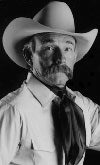Triangles have a unique place in our world. Engineers use them to build bridges; romance writers use them to manufacture chaos, Pythagoras used it to create his theorem and the shortstop uses it to make a double play! Triangles strengthen structures. They take three straight lines going nowhere and form a bond that can withstand great pressure. I see this cohesive combination in another triangle: Woman-horse-child. It is particularly evident when the child has Down’s syndrome, Multiple Sclerosis or any other disability which restricts their possibilities.
In many equine therapeutic riding programs that I’ve visited, women are the predominant hands-on helpers in the arena. To be successful, a mutual trust must be established. It is no secret that most young kids are more at ease with a mother figure. Children innately sense the mother’s compassion from her voice, her touch and her protective stance.
A woman introduces the child to the horse. This allows the child to give the horse the benefit of the doubt, because the woman trusts the horse and the child trusts the woman. When the child is set up on the horse’s back, it is still in the mother’s arms, ready to be rescued if need be.
Through a long progression of walks around the arena the child’s faith increases in the horse. The physical mother-child contact begins to loosen. It proceeds from holding one hand, to a hand on the back, to a hand on the saddle, to walking beside leading and then, one day, cheering from the sidelines.
The child’s trust eventually expands to include the horse. The triangle is complete. We have connected woman to child to horse and back to woman. This third leg was there before the child was born or was even a thought.
Woman-to-horse was always there. Not in all women, in all horses or in all kids, I admit, but in many. I have given up trying to understand the relationship. I have seen it so often I no longer think it is haphazard or coincidental. I have concluded it involves some primitive instinctual behavior.
It is especially obvious at any equine therapeutic riding center. Check it out for yourself. You will see small islands of woman-horse-child. Concentrate on one of those triangles. Try and drown out the chatter, the buckets and the racket going on around you.
Then imagine the child on the horse is yours. You become hypersensitive to the slightest movement – be it protective, encouraging or loving.
Even the smallest step in this magic triangle performance going on in the arena becomes magnified. Successes are marked in the tiniest gesture, the slightest touch, the tentative smile and the skip of a heartbeat. And through the cloud that puts you in the triangle, you hear the softest of voices saying, “It’s all right, he won’t hurt you.” PD



